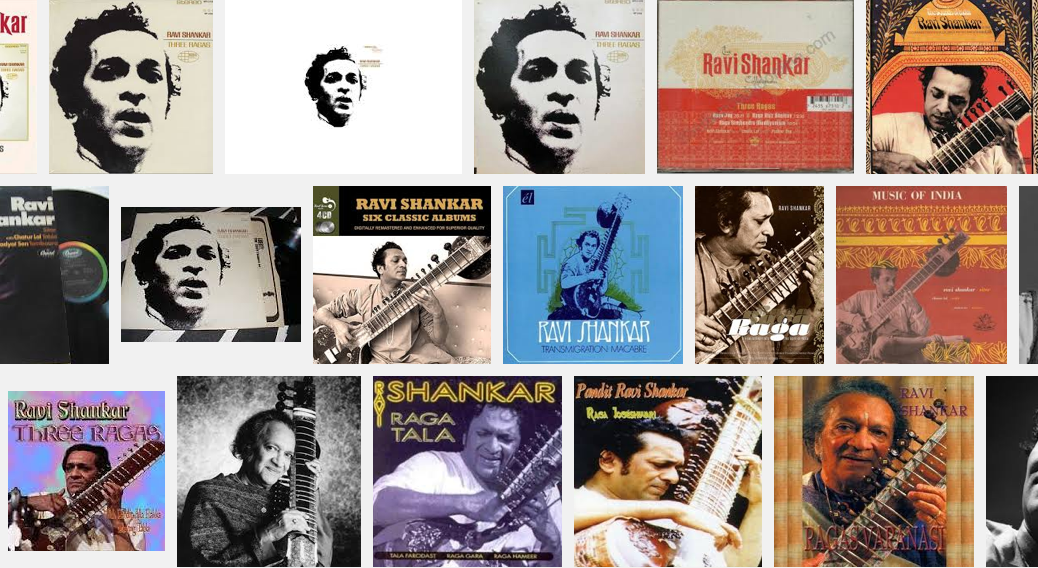Ravi Shankar – Three Ragas
When Ravi Shankar put out this album in 1956, the world was a small place, and Rock n’Roll was still an infant. Ten years later and Ravi Shankar had taught George Harrison how to play sitar and you could hear it on Beatles and Rolling Stones albums across the world. Beatles tracks like Norwegian Wood and Within You Without You, certainly gave the western ear their first taste of the distinctive tones and made it cool. Earlier than that even Brian Jones of the Rolling Stones had immortalised the ringing introductory sounds of Paint it Black.
A great album to put you into a trance, where your fingers fly across the keys and the next thing you know you have completed some words and are feeling better for it. This is one of the earliest and most famous Sitar albums and certainly one that will suck you in, if for nothing else, as an extremely effective tool to help you write.
A raga comes from the Sanskrit for colour or passion. The raga is based on a scale or set of notes with a set of motifs to create a mood. The form of the Raga has specific themes and cultural associations such as with the time or season. The raga is typical associated with the sounds of the tabla and sitar that are associated as the classical music of India, Bangladesh, and Pakistan. As a non-musician despite these associations I can hear blues, jazz, and gamelan related themes.
Released
1956
Lyrics
No lyrics
Mood
I don’t know how to describe the mood. The three tracks can go from slow to frenetic often in the same track. I like this variation of place and it can get me onto a real roll of fast typing. I smell incense when I listen to this music and it definitely has its own mood.
Good to work to
These ragas put you into a trance of typing and word production. It is a meditative piece that will take you away from yourself. I find this music takes me away from the cultural references that I tie music to when I hear it. This taking away from the everyday and normal, is essential to my creative process. When I’m listening to this music it clears away some of the static in my head. It certainly blocks out the other distractions that can get in the way of the flow of words.
Like
Sitar music is pretty unique. With that said, I can only compare it to other Sitar music. He is an acknowledged master of the sitar so rest assured it’s not too shabby a recording. I did look online to look at all of the other classical artists of the genre, but I don’t know enough of their work to give any worthwhile recommendation.
The Artist/s
Ravi Shankar is world music royalty. John Coltrane named his son Ravi after him. He is the father of Norah Jones. After touring the world with his brothers dance group. In 1938 he commenced studying sitar under the tutelage of Allauddin Khan. Through the forties and fifties Shankar performed and gained acclaim in India. In 1956 he toured the world and and recorded this album the three ragas.
Subsequently Shakar educated western audiences in Indian music. His most famous pupil was George Harrison of the Beatles who popularised the sitar for western audiences using it on multiple trances.
Born in 1920, Shankar died in 2012 after a long career winning multiple Grammys.
Other works
Shankar recorded many albums including Full Circle:Carnegie Hall 2000. I haven’t heard all of his music, but I can’t imagine that if you like this there won’t be much of his output you can’t get your hands on.
Where Can I buy it, and in what formats
You should be able to find this in any format you want. Although you might have to search for a little while to find it on vinyl. You should have no problem finding it on CD or as an MP3 from the usual commercial suspects.
The Verdict
I give this album a big thumbs up. This may be what you’d call a gate way drug that could send you into a world of Classical Raga enjoyment.
